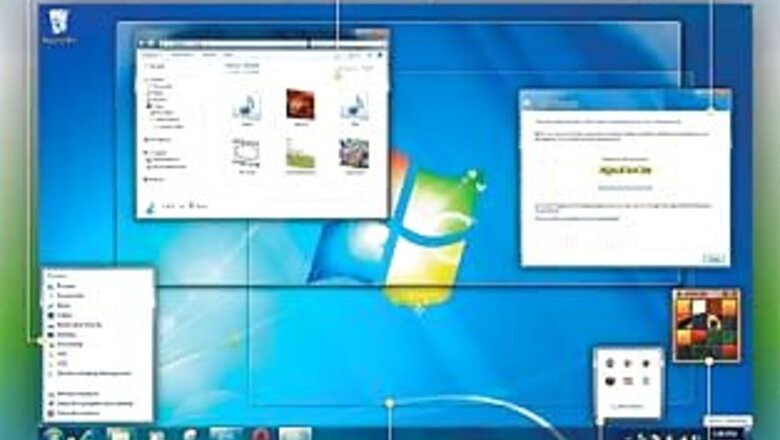
views
After Vista's less-than-stellar reception, it's a surprise to see that Microsoft's latest operating system introduction has been met with critical praise around the world. Most early testers have not found anything major to complain about in the beta versions and even the final release of Windows 7, which has been circulating privately for some time.
And now, it's the moment of truth - We bring you our verdict after spending more than a month with this final version of the successor to Vista (as well as XP, which many users have not given up despite its age). While it's clear a lot of effort has gone into making sure old mistakes are not repeated, there is a lot more to consider than just the hype.
Improving all the basics
Windows 7 is satisfied with fewer resources than those required by Vista: Microsoft recommends a 1 GHz CPU and 1 GB of RAM. The company has learned a lot from the mistakes made during the Vista launch: many teams of developers sat in their laboratories with everyday PC users and kept a close watch on them while they were working, as described in several blog posts that they have published. With this knowledge, they have tried to optimizeWindows ' handling. A few annoying things that users have had to struggle with for a long time have been eliminated, and new integrated functions like Aero Snap and Aero Shake on the desktop allow for entirely new ways of window management. You can now minimizewindows and call them up again with mouse gestures, e.g. a simple shake movement, or can also tile windows to half the screen with a familiar drag and drop.
Installation: The goal of making Windows 7's installation quicker and easier has largely been met. The process is entirely graphical and doesn't need much user intervention. You can set up your network during the process so you're ready to download the latest updates as soon as installation is done.
Taskbar: The new taskbar is the most obvious change, designed to make window management faster. It's more powerful, since it lets you launch programs and see previews of openwindows, but the changes will take some time to get used to. Text labels are gone by default, and the bar shows only an icon even if you have opened multiple copies of one application. When you hover the cursor over this icon,Windows 7 shows a live preview of the window contents complete with trendy Aero glass effects. Multiple open windows are shown as individual thumbnails in a horizontal bar, and programs can use their button space to show notifications such as file copy progress or error messages.
The former Quick Launch bar is therefore merged into the taskbar, which unfortunately makes it confusing to see which programs are actually running and which are not. Applications can be pinned so they are always on the taskbar whether running or not. Moreover, the familiar positions of your icons can sometimes change without the user realizing it. And you cannot just drag documents or media files onto the icons of applications to make them open instantly in those applications anymore. Luckily, the customization options let you turn on text labels, but you can't disable all the new modifications.
Desktop: The 'Show Desktop' icon in the Quick Launch area, which has been a familiar fixture, is no longer there. Instead of that you can call up the Aero Peek function using a new button at the end of the taskbar, even beyond the clock. If you hover over the button with the mouse, transparent outlines of all openwindows are displayed, so you can see the desktop through them. This kind of transparency effect does not necessarily consume your CPU power, sinceWindows 7 can accelerate it completely on the graphics card.
Aero also includes a snapping effect which lets you drag windows to the top or edges of the screen to maximize or tile them respectively (and the [Win] key can be used for loads of new shortcut combinations, including all the Aero Snap features). There is no demarcated sidebar for gadgets, which are still there, and can just be dropped anywhere on the desktop. Themes make it easy to group settings for wallpaper, sounds, and Aero glass color and opacity. And the OS finally includes the ability to rotate the wallpaper at adjustable intervals like a slide show.
Notification area: This has also been cleaned up; the most important change is it will show only system icons by default, i.e. the battery status, volume, network, and security alerts. All others are lumped into a flyout menu unless you specifically allow them to be displayed.
Jump lists: One of our favorite new innovations is the introduction of Jump Lists, which are program-specific context menus that replace the usual right-click context menus for icons in the taskbar and entries in the Start menu. They display lists of files frequently (or in some cases recently) opened with that application, but you can also pin your favorite files onto program icons, such as songs on your media player or bookmarks on the Web browser. Once you have done this, the Jump List becomes a practical feature that saves time and clicks. Applications such as media players can include playback control buttons, and future software releases will incorporate more such functionality to allow for quick controls and manipulations.
Libraries: Designed to help you cope with the ever-increasing mess of files, libraries act as virtual folders which aggregate your default 'My Documents' contents with any other locations on your hard drive(s). For example the 'Videos' library can show the contents of the 'Videos' folder as well as your movie collection on another hard drive and your shared home videos on an external storage device or networked PC.
You can even sort and organize libraries by file metadata including the date they were created, the artist, album, genre, length, etc. This makes it possible to manage and share all media files centrally. Libraries aren't just virtual though, you can save files to them and they will be placed in the default folder for that file type. As an added advantage,Windows Search indexes the libraries automatically. If you are searching for files that are stored there, Windows 7 shows you the results in a split second.
PAGE_BREAK
Enhanced Functions
Search: The integrated search function offers another new and practical feature, it not only rummages through the computer but can also be used to search specific sites on the Internet or a corporate server from the desktop. This feature was primarily intended for corporate environments, but requires only a small file in the Federated Search (also known as OpenSearch) OSDX format; so some sites have started offering them for anyone to download. The feature isn't immediately visible until you have installed these search connectors, after which they show up as options in the Search folder. We thus quickly browsed the image database at DeviantArt.com as well as Google News, and the results seemed as if they were stored locally. You can right-click and copy or save search results too.
Windows Media Player: Version 12 of the default media player has also taken a big leap forward. While Vista and XP users have always needed to install additional codecs or use extra software like the famous all-purpose VLC player just to view DivX movies from the Internet, Windows 7 includes almost all standard codecs such as AAC or H.264. WMP also hardly stresses the CPU even in the case of HD videos and remained under ten percent resource consumption in our observations. Media Center builds on this further with improved file handling from network storage and support for Internet TV.
Paint and Wordpad: Both these programs have received facelifts to make them look like Office 2010 with its second-generation Ribbon interface. This makes both of them stick out from the rest of the operating system; more so because they don't have enough features to justify the Ribbon. Still, Paint now comes with different brushes and you can create custom shapes.
Multitouch: We haven't been able to test Windows 7 on a touch-capable device yet, but laptops and tablets have already been announced by most manufactureRs With OS-level support for finger-based pinching and twisting, the way we interact with software could change profoundly. Notice how the taskbar is wider, and the icons are more spaced out-many parts of the OS have been designed to be finger-friendly. Early demos of drawing in Paint, playing interactive games and panning around Virtual Earth look great. Using touch to go through the Start menu or drag and drop files between folders will undoubtedly add a new dimension to our interaction with computeRs Aero Shake and Aero Snap suddenly make even more sense than they first appeared to.
Practical Additions
User Account Control (UAC): This should have brought more security to Vista, but it only put users off by constantly bombarding them with messages. Windows 7 now makes it less aggressive, for instance the user can deactivate messages that pop up when he/she makes deliberate modifications to settings. Windows 7 only shows warnings when programs want to modify the OS automatically. This new concept reduces the UAC dialogs by roughly 30 percent though this comes at the cost of a few new security risks. Yet, the balance will be better and the bigger risk of people disabling UAC altogether is avoided.
XP emulation: Windows 7 is characterized by its backwards compatibility; all Vista drivers can also run under the new operating system. Microsoft also offers a solution for older programs-the XP mode, which is only available in the Professional, Ultimate and Enterprise versions. You can make tools that are not compatible with Windows 7 run by means of virtualization. The free virtual XP integrates itself unnoticed into the actual operating system. Visually, there is no difference as the programs do not run inside a demarcated window which is common for virtual machines. In addition, we did not notice any significant lag in comparison with a pure XP installation. The host system is totally transparent. You can install tools so that they always run in XP mode, with regular shortcuts in the Start menu as if they were normal programs. But XP emulation increases the hardware requirements: 2 GB of memory and a processor that supports hardware virtualization are a must.
Action Center: This is where all your system-level alerts and maintenance tasks can be taken care of from. Like the erstwhile Security Center, you can check the status of your Windows updates, firewall, antivirus and backups. You can tweak notification settings, configure UAC, and even launch the System Restore wizard from here.
Speed improvements: If you have previously worked with Vista, you should find Windows 7 on the same hardware faster and more responsive. The new OS has plenty of tweaks and refinements to focus on pure performance. One indicator of this is that while Vista loaded 45 or more services on startup, Windows 7 loads only 30. Battery life on laptops is also noticeably improved, thanks partly to more aggressive settings for going to sleep and hibernating when idle.
Network configuration: Windows 7 offers many reasons for network administrators and even home users with multiple PCs to upgrade. They can now connect multiple PCs with improved file sharing and security measures with the 'Homegroups' function. You can exchange music, videos or documents between computers provided that Windows 7 is installed on all of them. XP users will be left out just like Linux and OS X users, but a Vista update to enable Homegroups has been hinted at. Setup is easy; if you didn't go through it during Windows' installation, you can create a Homegroup through the 'Network and Sharing Center' and determine what data you want to share. Then set a 10-digit password. Other computers are added to the group by entering this password. Windows 7 will then show these computers clearly in the explorer just like an external hard disk. The Windows media player also shows the shared songs and videos.
The complicated setup of network printers is also a thing of the past. With Windows 7, you just have to install the hardware once. All group members automatically get the driver and can use the printer as if it was connected directly. If you take your office laptop home, you can switch over to the home network (provided that the office computer is configured within a domain).
System recovery: If the PC refuses to start, Windows 7 has something new to help. The 'Repair' function which you can call up while booting using the [F8] key now offers an interface through which the user can import system recovery points or reconstruct a system image. Vista introduced the convenient Shadow Copies feature to revert to previous versions of files in its more expensive editions, and this is now also available in the Home edition of 7.
PAGE_BREAK
Sensors: Many laptops come with light sensors to control backlighting, but now the OS can be aware of outside conditions too. Sensors for light, noise, temperature, GPS location, physical direction and position, etc would enable a whole new generation of user-specific applications, and transform the way people use mapping services and follow directions. Of course a misused sensor also increases the possibility of super-targeted advertising and the potential damage that malware can do, so those worried about privacy can turn the feature off through the Control Panel.
Device Support
Drivers: Most current hardware should work on Windows 7 without a hitch, since there are no major changes to the device driver model like Vista had. That means upgraders won't face the same headaches that they did last time. In fact most major hardware vendors have had their drivers ready for a while now, and the nearly two months between 7's finalization and its retail launch will have given everyone enough time to make sure everything runs smoothly.
Device Stage: Although barely any devices support it right now, Device Stage is designed to allow users to control their peripherals through a standard interface. When plugged in, printers, cellphones, digital cameras and other peripherals that support Device Stage will launch a window allowing you to perform common tasks such as syncing files and performing diagnostics, as well as order consumables from the manufacturer and check the battery status. Device Stage windows will be customized with the product image and manufacturer's branding.
Graphics: More of a software improvement, Windows 7 will of course be the first version to enable DirectX 11 with compatible graphics cards. Its DirectCompute component accounts for the smoothness of the Aero effects, since these are handed off to the graphics processor. DX11 will also allow the next generation of 3D games to use more realistic effects, better shadows and improved multi-threading.
Virtual Wi-Fi: This feature is so ambiguous that we wouldn't have discovered it without prompting from Microsoft, and we apparently need new drivers before it can be tested. But the basic idea is that the OS can now recognize multiple virtual instances of your Wi-Fi adapter, letting you establish multiple connections without additional hardware. In theory, this should let you share a Wi-Fi connection with other devices, connect to multiple Wi-Fi networks simultaneously, or create a mesh in which PCs access the network through each other to boost range.
Virtual Hard Drives: Windows 7 can natively mount VHD virtual hard drive files as regular volumes, which are treated just like physical drives or partitions. You can even boot into another instance of Windows 7 which is installed in this virtual image.
Features and Corporates
Apart from enhanced media and user friendliness, Windows 7 comes with a few features designed to make corporate deployment easier. Most of these will be available only in the Business and Ultimate editions.
Direct Access: For those running Windows Server 2008 in their corporate environments, Direct Access allows for secure remote connections without the hassle of setting up a Virtual Private Network. It requires IPv6 and some fairly specific network infrastructure, but should allow for new levels of remote management and ease of access to networked storage, resources, and business applications.
BitLocker To Go: Drive encryption is now extended to removable drives to protect their contents even if they are physically lost. Administrators can set policies requiring BitLocker to be enabled before external drives can be used at all.
AppLocker: Similar to BitLocker, AppLocker lets administrators control which programs are allowed to run on the desktops they control. Security is enforced by pre-approving software and preventing users from installing whatever they like, but letting software update itself without upsetting the rules.
Branch Cache: For users on a single network across multiple physical locations, network resources can be cached locally to eliminate long file transfer times. Branch offices can have their own copies of data usually hosted exclusively at the head office. Permissions can be set for security, and bandwidth can be saved by reducing incremental transfeRs
Conclusion
With Windows 7, Microsoft has launched a well-thought-out and fast operating system which manages with fewer resources than its predecessor Vista required. The Home Premium version is the most suitable for a normal user; it comprises all important things like the HomeGroups functionality, multitouch support and the Media Center. Those who need professional features like the XP mode, AppLocker and VHD support should go for the Ultimate edition. Those buying new netbooks, laptops and PCs in the near future might also have the choice of the Starter and Home Basic versions.
Whichever you choose, Windows 7 is fully stable and ready for mass public use, and should not cause any problems. Upgrading from XP is worthwhile in most cases, and even Vista users will appreciate the better handling and new conveniences.
Prices
Windows 7 Home Basic - Rs 5,899
Windows 7 Home Premium - Rs 6,799
Windows 7 Professional - Rs 11,199
Windows 7 Ultimate - Rs 11,799




















Comments
0 comment